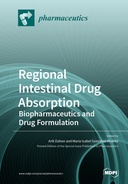Explore

Regional Intestinal Drug Absorption
0 Ungluers have
Faved this Work
Login to Fave
The gastrointestinal tract (GIT) can be broadly divided into several regions: the stomach, the small intestine (which is subdivided to duodenum, jejunum, and ileum), and the colon. The conditions and environment in each of these segments, and even within the segment, are dependent on many factors, e.g., the surrounding pH, fluid composition, transporters expression, metabolic enzymes activity, tight junction resistance, different morphology along the GIT, variable intestinal mucosal cell differentiation, changes in drug concentration (in cases of carrier-mediated transport), thickness and types of mucus, and resident microflora. Each of these variables, alone or in combination with others, can fundamentally alter the solubility/dissolution, the intestinal permeability, and the overall absorption of various drugs. This is the underlying mechanistic basis of regional-dependent intestinal drug absorption, which has led to many attempts to deliver drugs to specific regions throughout the GIT, aiming to optimize drug absorption, bioavailability, pharmacokinetics, and/or pharmacodynamics. In the book "Regional Intestinal Drug Absorption: Biopharmaceutics and Drug Formulation" we aim to highlight the current progress and to provide an overview of the latest developments in the field of regional-dependent intestinal drug absorption and delivery, as well as pointing out the unmet needs of the field.
This book is included in DOAB.
Why read this book? Have your say.
You must be logged in to comment.
Rights Information
Are you the author or publisher of this work? If so, you can claim it as yours by registering as an Unglue.it rights holder.Downloads
This work has been downloaded 178 times via unglue.it ebook links.
- 178 - pdf (CC BY) at Unglue.it.
Keywords
- absorption-modifying excipients
- BCS class IV drugs
- BCS drugs
- bioequivalence
- biomimetic membrane
- Biopharmaceutics
- Biopharmaceutics Classification System
- clinical studies
- colon absorption
- combined zero- and first-order absorption
- controlled release drug product
- DDI
- disintegration
- dissolution
- dissolution test
- drug absorption
- drug permeability
- drug solubility
- drug solubility/dissolution
- drug-drug interactions
- Economics, finance, business & management
- Energy Intake
- enteric-coated
- first-order absorption
- first-pass effect
- Franz cell
- Franz–PAMPA
- furosemide
- gastrointestinal
- gastrointestinal hormone
- GastroPlus
- hierarchical support vector regression (HSVR)
- human colon carcinoma cell layer (Caco-2)
- Ibuprofen
- ich
- in silico modeling
- in situ perfusion
- in vitro
- in vitro in vivo extrapolations
- Industry & industrial studies
- intestinal absorption
- intestinal perfusion
- intestinal permeability
- IVIVE
- location-dependent absorption
- Manometry
- Manufacturing industries
- mechanistic modeling
- medicine
- microdevices
- mucoadhesion
- nutrient absorption
- nutrient digestion
- Obesity
- oral absorption
- oral drug delivery
- oral peptide delivery
- passive drug transport
- PBBM
- PBPK
- permeation enhancers
- pharmaceutical development
- Pharmaceutical industries
- pharmacokinetics
- Phoenix WinNonlin
- physiologically-based pharmacokinetic (PBPK) modeling
- postprandial glycaemia
- pravastatin
- Quality control
- region of the gut
- regional intestinal permeability
- regional/segmental-dependent permeability and absorption
- route-dependent intestinal metabolism
- segmental-dependent intestinal permeability
- segregated flow intestinal model (SFM)
- Shape
- traditional model (TM)
- transit compartment absorption model
- type 2 diabetes
- zero-order absorption
Links
DOI: 10.3390/books978-3-0365-3657-6Editions

